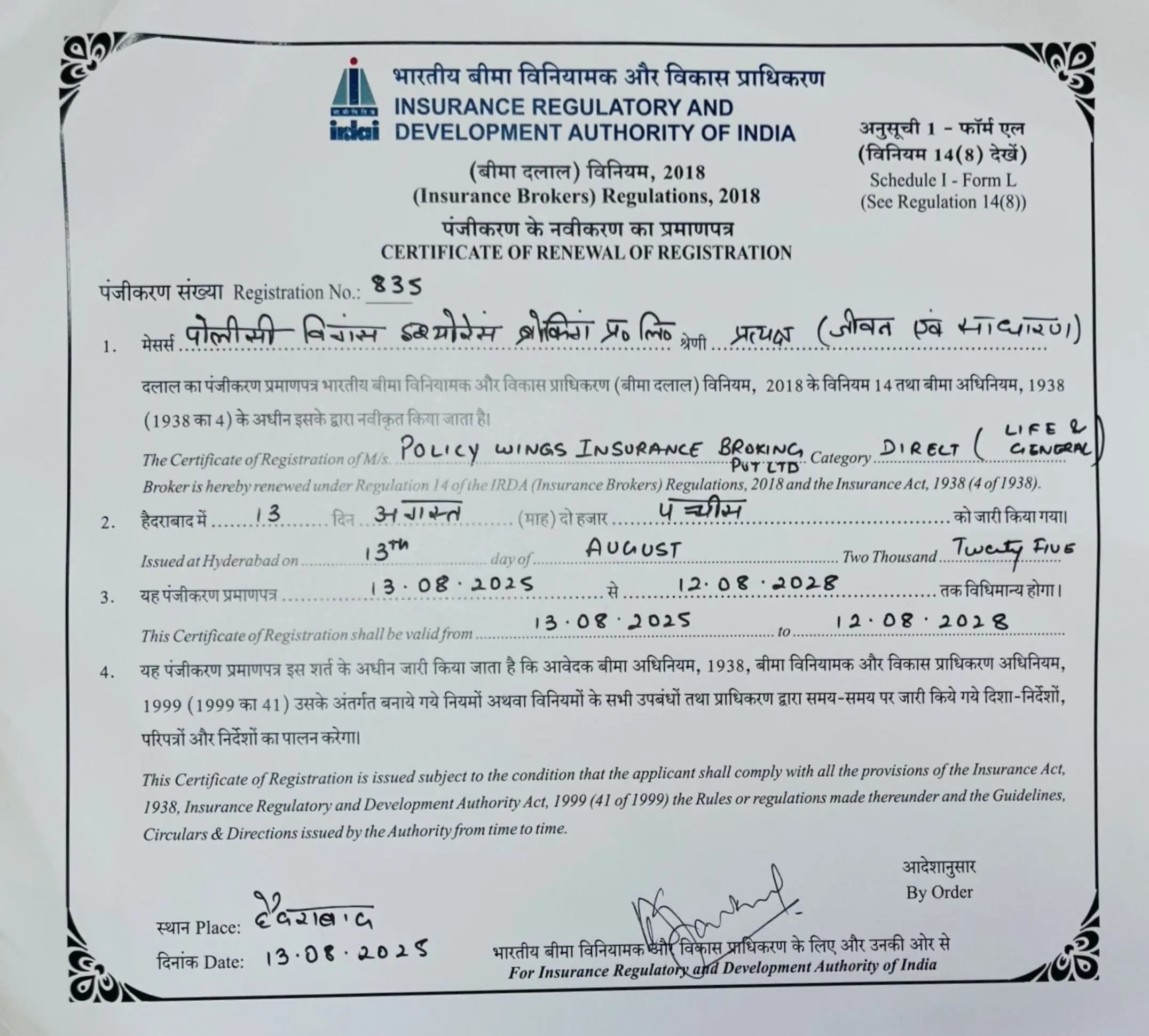Sum Insured In Health Insurance
Sum Insured In Health Insurance
Considering the current rate of medical inflation, the experts opine that investing in a befitting health insurance plan is a wise move to efficiently handle medical emergencies. A three or four-day hospitalisation tenure is enough to deplete a significant portion of your hard-earned money. A health insurance coverage plan acts as a protective shield under such circumstances.
However, the technical jargon of health insurance might prove to be quite tricky to understand. However, it is very crucial to resolve all the ambiguities beforehand to avoid any future misunderstandings. Unless you do not understand all the relevant terms and conditions of the concerned plan, you cannot ensure optimum coverage, as you might miss out on some special opportunities to earn some additional benefits or bonuses.
Among some of the most significant insurance terms, one is called sum insured. It is an indispensable factor for health insurance. You must ensure to learn all the related aspects of the sum insured before purchasing a health policy.
This article will critically highlight in detail all the relevant aspects of the sum insured in health insurance.
What is the sum insured in health insurance?
The sum insured is the pre-specified limit up to which the respective health insurance provider will bear the medical costs during hospitalisation, as per the concerned policy terms and conditions. This is the optimum coverage limit that the insurance provider can offer during claim settlement. Any excess expenses incurred during the process will have to be borne by the policyholder.
Example
A 19–year–old boy who is covered under his father’s family floater plan, suddenly suffers from malaria and has to be hospitalised. The total hospital bill amounted to INR 75000. The total sum insured amount is INR 500000. Except for the deductibles and certain other minor exceptions, the entire bill was settled by the insurance provider.
6 months after this incident, the boy’s younger sister faced an unprecedented road accident and got seriously injured. She needed surgery and the hospital bill amounted to INR 4.5 lakhs.
The sum insured amount helped their father to receive optimum coverage under both circumstances in the following manner:
| PARAMETERS | MALARIA HOSPITALISATION | HOSPITALISATION FOR ACCIDENT |
| Hospital bill | INR 75000 | INR 450000 |
| Claim amount | INR 75000 | INR 425000 |
| OOP expenses | INR 7500 (10% deductibles) | INR 675000 (10% deductibles + rest of the hospital bill amount) |
| The remaining sum insured amount | INR 425000 | NIL |
Under both the circumstances, the policyholder had to bear the 10% cost of deductibles and after the accident instance, the sum insured amount got exhausted.
Considering both instances, the total OOP expenses amounted to INR 7500+INR 67500. If he did not have health insurance protection, this amount would have risen to INR 5.25 lakhs.
This example clarifies the working strategy of the sum insured in health insurance.
What is the impact of the sum insured on health insurance premiums?
The amount of sum insured has a direct impact on the premium amount of the concerned health policy. Technically speaking, the sum insured determines the total coverage amount that can be borne by the insurance provider in the case of any medical emergencies during the policy term.
Therefore the more the sum insured amount, the more the insurance company can pay. This means that the premium amount for a higher sum insured health plan is comparatively higher as it ensures a better coverage span.
Factors to calculate the right sum insured for your health plan
Some of the most significant factors that you need to consider for calculating the right amount of sum insured include the following:
1. Health plan type: The market is loaded with several types of health plans including, individual health policies, family floater plans, critical illness covers, group plans, etc. The amount of sum insured will depend on the type of health plan you seek to purchase. A family floater health plan will have a comparatively higher sum insured amount than an individual plan.
2. Total number of members covered: Certain plans like group plans or family floater plans cover more members than individual plans. Therefore, the sum insured amount ends up being higher if there are more covered members. It offers some margin for efficiently using the sum insured amount to handle medical contingencies during the plan term. Low-sum insured limit risks of rapid exhaustion, thereby enhancing the chance of OOP expenses.
3. Medical history of the insured individual(s): Some people develop certain chronic health conditions like diabetes, asthma, kidney issues, etc. that require frequent medical attention. Under such circumstances, it is best to go for a high sum insured amount for effective management. The age of the insured person is also considered here as old age is more prone to health risks. Considering all these factors, it is best to keep the sum insured amount high.
4. Total number of dependents and income: Your yearly income limit might help you in determining the sum insured amount or the need for the maximum number of dependents. If the income level is on the lower side, then it is best to save to pay the premium of health insurance with a comparatively higher sum insured amount. This ensures better coverage, keeping you stress-free during medical emergencies. While purchasing a health plan, always consider the total number of dependents who will be covered under the plan. The more number the number of dependents, the higher the sum insured amount.
5. Local availability of quality medical facilities: Cities and metros offer comparatively better medical facilities than small towns or villages. Therefore, health plans in cities cost more than in other places. You need to consider this factor while choosing the right amount of sum insured.
6. Existing health insurance coverage: While purchasing a new health plan, always ensure to calculate the optimum usable amount of the sum insured. If you are a working professional, you might be covered under the employers’ group plan. However, such covers are not very helpful in the long run, as they are automatically terminated at the end of the particular employment. You can keep an individual plan for backup.
Why is it important to choose the right sum insured in health insurance?
You must be wise enough to choose the right amount of sum insured for your health plan to ensure optimum coverage and protection during any medical issues. Otherwise, the very purpose of maintaining a health plan will fail if you have to incur too many OOP expenses to handle any medical misfortunes.
Wisely choosing the correct sum insured amount depending on your requirements is very critical as it ensures:
1. Enhanced financial cushion for better handling of medical emergencies
2. Deftly preserves your hard-earned money and takes care of your savings
3. It retains your peace of mind during medical contingencies by providing a financial safety net
4. Allows sufficient coverage, reducing the risk of OOP expenses
Benefits of choosing the right sum insured
Choosing the right sum insured amount requires careful observation, perseverance, and wise decision-making capacity to ensure optimum utilisation of your health plan. Some of the most highlighting benefits of choosing the right sum insured amount include the following:
1. Deft finance management: Medical emergencies can be unprecedented and can prove to be quite burdensome if you do not possess a befitting health insurance plan. However, a proper health plan is efficient enough to handle such contingencies and save your hard-earned money, ensuring proper management and utilisation.
2. Stress-free: Getting proper rest, and remaining anxiety and stress-free along with proper medical care and treatment are some of the most significant essentials during treatment. However, if you constantly keep worrying about the mounting hospital bills, it will have adverse effects on your health. But, if there is proper health insurance coverage, you need not have to focus on these matters and get the best possible treatment and care, ensuring a speedy recovery.
3. Family floater policy: A family floater health insurance is an umbrella cover covering all the family members under a single health plan. The total sum insured amount is shareable among all the members covered. Therefore, the larger your family is it is advisable to opt for a considerably larger sum insured amount to ensure sufficient coverage.
4. Better treatment: When you possess a befitting health insurance policy with a sufficient sum insured amount, you can ensure the best possible medical treatment without any compromise or worrying about the finances. However, you may have to compromise on certain aspects if the sum insured is comparatively lower.
5. Optimum financial coverage: Insufficient sum insured enhances the risk of increasing OOP expenses. However, you can be financially stress-free with sufficient coverage.
6. Hassle-free multiple claims: There is no restriction on the number of claims you can make. You can continue claiming till the sum insured amount gets exhausted. This is especially helpful if the sum insured amount is higher.
7. Option for claim settlement till the end of the policy tenure: Lower sum insured amount risks rapid exhaustion, exposing you to several financial liabilities for different other claims. A sufficient sum insured lowers the possibility of such instances, ensuring better coverage.
Difference between the sum insured and sum assured
PARTICULARS | SUM INSURED | SUM ASSURED |
UTILITY | The optimum amount that the concerned health insurance provider offers for compensating the medical costs incurred during hospitalisation. | The optimum amount that is provided by a life insurance company either on the death of the policyholder or on the maturity of any life insurance policy. |
TYPE OF INSURANCE | This term is exclusively used for general health plans. | This term is exclusively used for life insurance policies. |
COVERAGE TYPE | Every hospitalisation expense incurred up to the sum insured limit is borne by the concerned insurance provider. | Sum assured is available in life insurance plans either during an earlier death of the policyholder or at the end of any running life insurance plan. |
EXAMPLE | A sum insured amounting to INR 5 lakhs can be utilised for settling the hospital bills during hospitalisation. Therefore, the claim amount can be either less than or equivalent to the optimum sum insured amount depending on the total amount of hospital bills. | A sum assured of INR 10 lakhs is provided on completion of a life insurance plan or if the policyholder passes away during the plan tenure. In both cases, the claim amount will be equivalent to the sum assured amount. As per applicability, it may also include bonuses, loyalty enhancements, etc. |
NUMBER OF CLAIMS | Several claims can be made till the exhaustion of the entire sum insured amount. | Generally, the total sum assured gets paid in a single payout against one single claim. |
USAGE | The sum insured gets utilised for indemnity-based plans i.e., for recovering only the lost amount for a specifically incurred event. | It can be utilised as per the necessities of the policyholder during the insured event. This is a fixed benefit. |
MATURITY BENEFITS | The sum insured is not a maturity benefit. | Depending on the category of the concerned insurance policy, the sum assured can be a maturity benefit in the case of a life insurance plan. |
APPLICABILITY | You can easily file a claim for your existing plan and receive the reimbursement of the actual cost that you have incurred | You can only claim this benefit at the end of the policy tenure in the case of a maturity benefit, or your legal beneficiary can claim it if you pass away during the policy term. |
Things to keep in mind while choosing the right sum insured
Choosing a sufficient sum insured amount for your health plan is essential to ensure befitting coverage protection and efficient finance management during medical emergencies. Certain crucial factors that you need to consider while determining the right amount of sum insured include:
1. Age: Buying a health plan early in life proves to be more beneficial as it remains cheaper and you can enjoy optimum coverage at a comparatively lower price. Moreover, while you are still young, your health remains comparatively stronger, making it easier for you to serve the waiting period for certain typical ailments without any hassle.
2. Health status: If you have any pre-existing health issues, like diabetes, hypertension, kidney issues, heart issues, etc. it is better to opt for a comparatively higher sum insured amount. It is essential because such health conditions require frequent medical attention and regular monitoring.
3. Lifestyle: Nowadays lifestyle diseases are witnessing a steep and steady rise. Therefore, if you live a sedentary and unhealthy lifestyle, you are more prone to different health ailments.
4. Life stage and number of dependents: If you maintain a number of dependents, you need to consider enhancing your insurance overage span to ensure optimum protection for all.
5. Opt for a comprehensive plan: If you are responsible for handling your entire family, it is best to go for an umbrella plan. It allows you to take care of the medical needs of your entire family. You can insure the health of all your beloved family members just by paying a single premium.
6. Opt for a top-up or super top-up plan: These sorts of plans offer you an additional protection layer if your hospital bill amount exceeds the sum insured amount of your basic health plan. Super top-up plans even cover pre- and post-hospitalisation costs incurred.
7. No Claim Bonus: Most health insurance providers offer NCB or No Claim Bonus for not raising any claim during the policy term. It is accrued and eventually enhances the sum insured amount during plan renewal for the following plan tenure. Apart from this, the renewal charges may also be reduced due to the accumulated No Claim Bonus.
8. Restoration benefit: This is an additional coverage that you can buy with your basic health plan. If you or any of the covered family members are prone to frequent health issues, it carries the risk of the sum insured is exhausted. If you purchase this benefit, then the insurance provider will restore the entire sum insured amount on exhaustion without any additional charges.
When can you increase the sum insured of your health insurance policy?
Depending on your altering requirements and changing lifestyle, you might need to upgrade your existing health insurance policy at regular intervals. Moreover, if it remains static at a particular point, might prove it to become less competitive considering the medical market inflation. Therefore, after carefully considering your current financial status, the number of dependents, the overall health status of all the covered members, etc. you must upgrade your health plan every 6 to 7 years on an average.
Almost all health insurance providers offer you the opportunity to upgrade your existing health plan during renewal. Once the policy tenure is over, you can continue with the same plan on renewal by enhancing the sum insured amount.
Although an upgraded sum insured amount will cost you a higher premium amount, that will prove to be comparatively negligible to the hospital and treatment costs that you might have to face during any unfortunate event.
A sufficient sum insured coverage ensures enhanced financial protection against any unfortunate medical event and effectively reduces the risk of incurring out-of-pocket expenses.
Frequently Asked Questions
The sum insured amount and health insurance premiums are directly proportional to each other. This means that you can purchase a health plan with a higher sum insured amount by paying a higher premium amount.
Yes, it can be done during policy renewal. You can also add a top-up or a super top-up plan to your existing plan to enhance the coverage scope.
Deductibles imply the pre-fixed amount the policyholder must bear during claim settlement. Generally, it is fixed at 10% of the total claim amount in the case of health insurance. However, depending on the terms and conditions of the concerned plan, it may even differ.
It implies the benefit the respective insurance provider offers for reissuing or restoring the sum insured once it gets exhausted.
Yes, the sum insured is the optimum limit up to which the insurer will bear the treatment costs during hospitalisation. Any excess must be borne by the policyholder.
Leading Health Insurance Companies





Latest Blogs
Introduction While buying or renewing car insurance, you would surely come across two very common terms: Zero Depreciation and...
Introduction In India, getting insurance for your car is non-negotiable. With so many plans and so many add-ons available, it...
Introduction Everyone deserves healthcare but sadly, with the medical expenses rising so fast in India, not everyone can afford...
Introduction Do you think that buying life insurance means having to go through complicated policies and paperwork and paying...
Introduction You don’t buy a car insurance just fulfil a legal requirement. The repair costs have really increased, spare...
Introduction You can’t predict life but it’s always possible to secure the financial future of your family with life...
Introduction You have waited so long to finally purchase that car, saved for it and checked all those reviews....
Introduction Upon buying insurance, you will notice different short forms in your policy documents that might confuse you. One...









